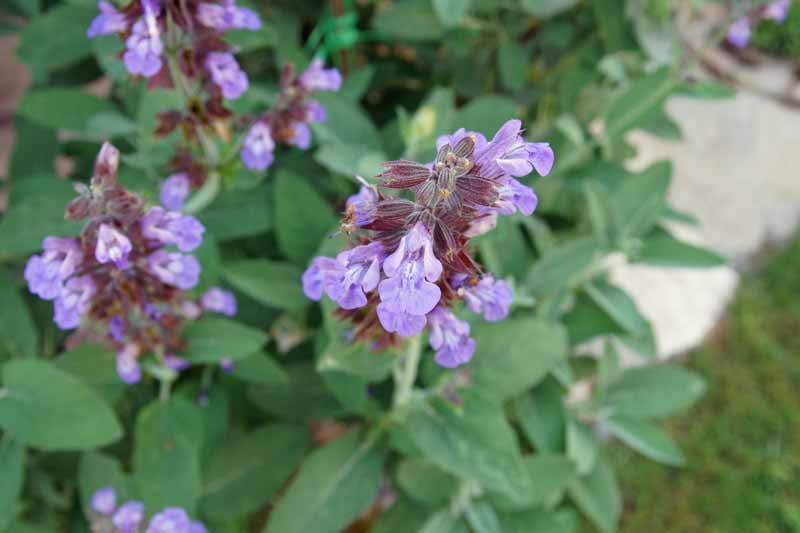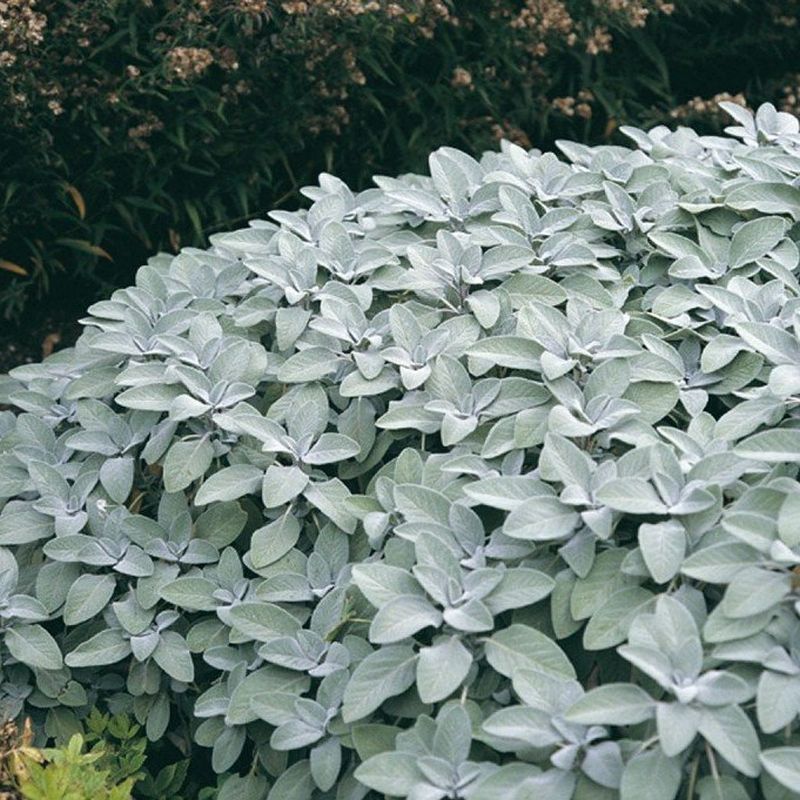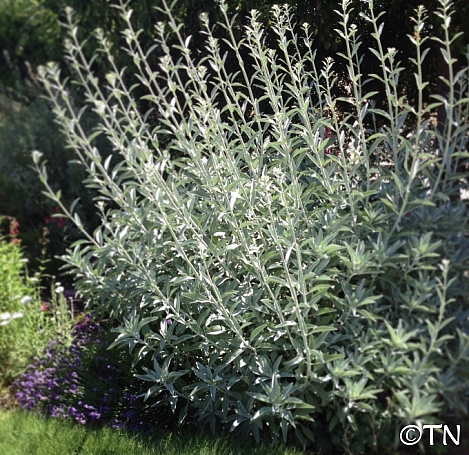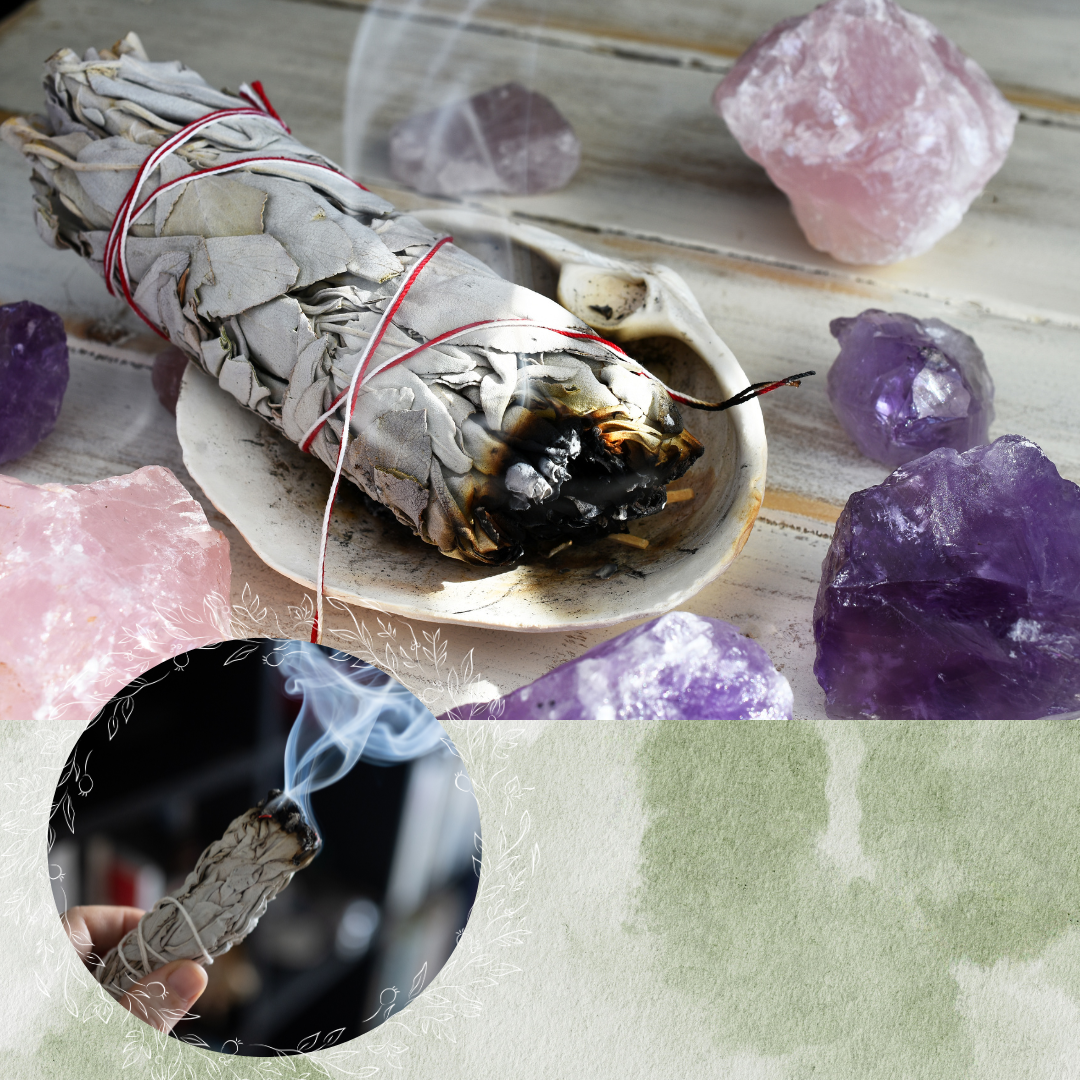
Garden Sage [Salvia officinalis]
Image Credit: Gardener’s Path
Height: 18″ – 36″
I love purple accents in my garden, and I like the lavender blooms on common garden sage. In addition, the smell of this plant returns me to my childhood Thanksgiving feasts. Garden sage smells of turkey and dressing, mom, and brisk November nights.

Bergartten Sage
Image Credit: Star Nursery
Height: 18″ = 24″
This year, I am also trying Bergatten Sage

White Sage [Salvia apia]
Image Credit: California Flora Nursery
Height: 36″ – 60″
Not long ago, I attended a Native American drumming festival and watched an old, weathered chief cleanse the area with the smoke from a smudge made of white sage. Since that time, I have wanted to grow my own white sage, and this year, I have added a plant to my garden.

White Sage [Salvia apiana]
Height 36′ – 60′
The smell of burning white sage reminds me of campfires, summer camp, and warmth. After I attended that ceremony, I began looking for a white sage plant to grow in my garden.
I have discovered that white sage was widely used by several Native American tribes:
Uses
“Ethnobotanic: White sage seeds were one component in pinole, which was a staple food of the Indians of the Pacific coast (Barrows 1977). Seeds were collected with a seed beater basket and flat basket,and were parched and ground into meal. The Cahuillas of southern California used this meal to create a mix with one part meal, three parts wheat flour, and a little sugar. This mixture was eaten dry, mixed with water to form gruel, or baked into little cakes or biscuits. The seeds were harvested in quantity and stored in baskets in the home. The tribes, north of Santa Barbara, kept small baskets of seeds and other foodstuffs on hand, with some stored for the winter. The Chumash and other California tribes also ate leaves and stems of white sage.
“The Cahuilla, Costanoan, DiegeÒo, Kawaiisu, and Maidu tribes of California used white sage or chia seeds to clean and heal their eyes (Strike 1994). One method was to place a few Salvia seeds in their eyes at bedtime. During the night, the seeds would swell and become gelatinous. Moving around under the eyelids during sleep, the seeds collected any foreign substances on the eyeballs. In the morning the seeds were removed, leaving the eyes clear and free of contaminants. Cahuilla women drank an infusion of white sage roots after giving birth to remove the afterbirth and promote internal healing. White sage seeds were eaten by the Cahuilla to cure colds. The DiegueÒo used white sage tea for this purpose. Leaves of white sage were smoked, made into a tea, and used in sweathouses to cure colds. White sage leaves were also used by the DiegueÒo as a shampoo to clean their hair and to keep it from turning gray. Crushed leaves were rubbed on the body to eliminate body odor; this was often done by Cahuilla men before they went hunting. The smoke from burning white sage is used widely by many Native groups as part of their purification ceremonies. White sage is widely valued and cherished among many Indians and other cultures today, prized for its soft “feminine” qualities (Stevens, unpublished field notes, 1998).
Description
“General: Mint Family (Lamiaceae). White sage is a perennial sub-shrub less than 1 m tall. Leaves are generally 4-8 cm long, lanceolate, with a tapered base and minute teeth. The leaves are simple, with dense hairs and a distinctive fragrance. The inflorescence is many-flowered raceme with white to pale lavender blossoms. The fruits are light brown, shiny nutlets.
Cuttings:
“Gather soft wood cuttings of young vegetative shoots before the plant has flowered. The rooting ability of these cuttings is enhanced by collection and preparation in the spring. Collect cuttings 3-4 inches long, and remove the lowest pair of leaves. Dipping the basal 1-2 inch portion of the cutting in rooting hormones enhances rooting. Bury the cuttings so that the lowest node is ½ inch under ground. Plants will root quickly if they are going to survive. If the cutting material is too hard, rooting may take a long time, or cuttings won’t ever root. If the cutting material is too soft, it will rot. It takes some experience to collect the cuttings at the right time. Cuttings establish more readily if kept warm under the flats for weeks at 20 to 30° C (68 to 86° F). Once roots are established on cuttings, plant them in 2″ or 4″ pots. Pot them in bigger containers as the plants grow. Salvia apiana grows rapidly, so it is usually ready to out-plant in 6 months to a year in southern California (warmer climates). In northern California, out-plant when the plants are a year old because the winters are sometimes too severe for them. It is best to outplant in the fall; don’t plant in the summer.” USDA Plants